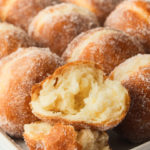
Brioche Donuts
Consider this your ultimate, mama approved, expert guide to making brioche donuts!
Ingredients
For the dough:
- 4 ½ cups bread flour
- 1 cup warm milk
- 2 large eggs + 1 egg yolk room temperature
- 1/2 cup unsalted butter softened at room temperature
- 3 Tablespoons granulated white sugar
- 2 teaspoons instant yeast see note for active dry yeast
- 1/2 teaspoon sea salt
- Neutral oil like vegetable, canola or sunflower for frying
For the garnish:
- 1 cup sugar additional, set aside for tossing
Instructions
- ATTENTION! Read through the recipe before starting and measure all your ingredients in advance. Go back and watch my full video tutorial, read my expert tips and extended instructions with photos. Use metric measurements and weigh the dry and wet ingredients for best accuracy as my recipe. Toggle back and forth between US Customary and Metric measurements in the ingredients section above.
- In a stand mixer bowl, add flour, 2 Tablespoons sugar, yeast and salt. See notes below if using active dry yeast. Use the dough hook attachment and while the mixer is on, add warm milk, eggs and softened butter, one tablespoon at a time.4 ½ cups bread flour, 1 cup warm milk, 2 large eggs + 1 egg yolk, 3 Tablespoons granulated white sugar, 1/2 cup unsalted butter, 1/2 teaspoon sea salt, 2 teaspoons instant yeast
- Mix on low speed for 8-10 minutes. The dough should be tacky but not sticky, soft and easy to stretch. If it's sticky, add a few spoonful of flour and continue to knead until the dough comes together. Lightly coat the bowl and dough with oil, cover with plastic wrap and a tea towel.
- Let it rise in a warm spot at room temperature for at least 1 ½ hours. This first rise is called bulk fermentation. It allows the yeast to ferment the dough, developing flavor and helping the gluten structure form.
- Punch the dough down. Divide into 12 pieces for extra large donuts, 15 pieces for large donuts or 20 equal pieces for medium donuts.
- Working with one piece of dough at a time, pinch the edges into the middle, forming a small pouch. Place the ball of dough, seam-side down on a clean work surface, cup your hand over it, and lightly roll it into a ball, using the back of your palm and the friction of surface to help with the rounding.
- Place each ball on pre-cut parchment sheet. Cover with a tea towel and let it rise for 30-40 minutes. This second rise is called proofing. It occurs after the donuts are shaped. This shorter rise allows the dough to develop a little more volume and improves the final structure.
- Heat oil in a large, heavy bottom Dutch oven or pot. Use a thermometer to keep the temperature between 350°F to 355°F / 176°C to 179°C.Neutral oil like vegetable, canola or sunflower
- Gently place three donuts into the oil at a time, leaving space for them to puff up and move around. The more donuts you fry, the temperature of the oil will drop. Bigger donuts need 3-4 minutes on each side. Smaller donuts need 2-3 minutes on each side. See notes for expert tips on frying. After the recommended frying time, the color of the donuts will be dark brown.
- Remove from the oil using a slotted spoon and place on a baking tray lined with a wire rack or paper towels. This helps drain the excess oil off. Repeat until there are no more donuts. Toss in granulated sugar, powdered sugar or enjoy as is.1 cup sugar
Video
Notes
- I suggest using metric measurements and weighing the dry and wet ingredients for best accuracy. If you don't have scale, please measure liquids at eye level and flour with the fluff, spoon and level method. See How to Measure Flour blog post.
- If using active dry yeast, first measure 240ml or 1 cup of warm milk from the recipe in a wide mouth cup or bowl. Add in a teaspoon of sugar and sprinkle the yeast on top. Whisk together to combine and let it sit for 8-10 minutes until foamy and bubbly on top. Then, add to the dry ingredients, along with the remainder of the milk and proceed with baking directions. For extended instructions, see Active Dry Yeast vs. Instant Dry Yeast blog post.
- The best temperature for frying brioche donuts is between 350°F to 355°F / 163°C to 179°C. If the oil is too high, the outside of the crullers will burn and the center will be undercooked. If the oil is too low, the donuts will absorb more oil, making them heavy and greasy. To avoid those two things, the best practice is to stay within the recommended frying temperature and watch for any fluctuation of the thermometer. Shop my exact thermometer here. (Affiliate link)
- Brioche donuts are best served fresh and hot. I bet there won't be any leftovers but in the event that you do, they store well for 1-2 days at room temperature. Wrap leftovers in plastic wrap and a kitchen towel. This locks in the moisture and prevents the donuts from drying. If making ahead, I suggest saving any filling in the refrigerator until serving.
Nutrition
Calories: 252kcalCarbohydrates: 43gProtein: 5gFat: 7gSaturated Fat: 4gPolyunsaturated Fat: 1gMonounsaturated Fat: 2gTrans Fat: 0.2gCholesterol: 16mgSodium: 80mgPotassium: 55mgFiber: 1gSugar: 15gVitamin A: 190IUVitamin C: 0.005mgCalcium: 8mgIron: 0.4mg
The provided nutritional value above is an estimate per serving. 100% accuracy is not guarenteed. Please see Nutrition Information Disclaimer in our Privacy Policy.
Nutrition Information Disclaimer Have you tried this recipe?Please leave a comment/review below!